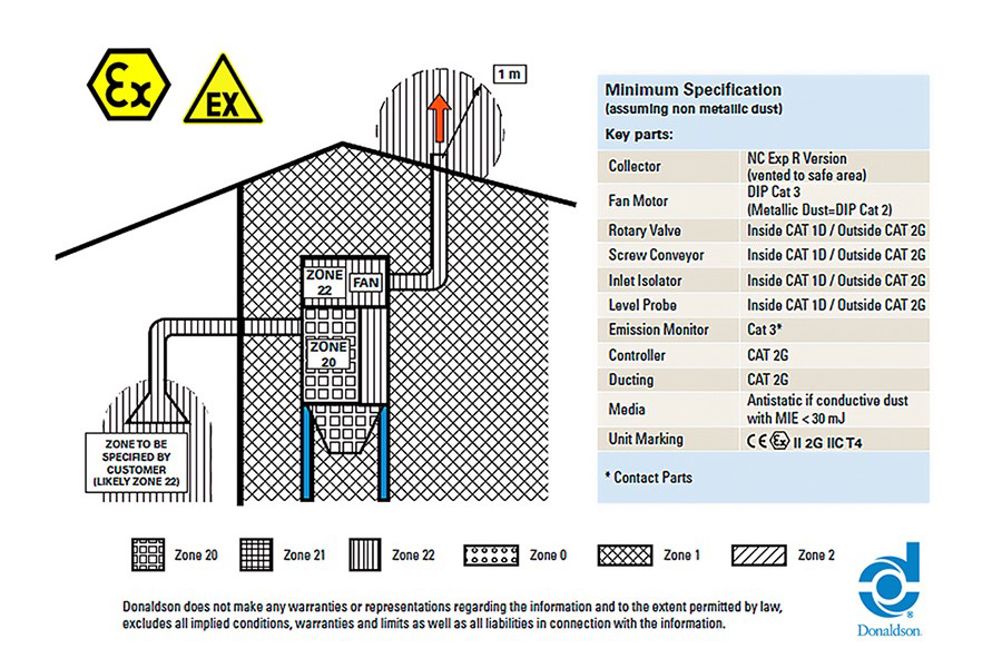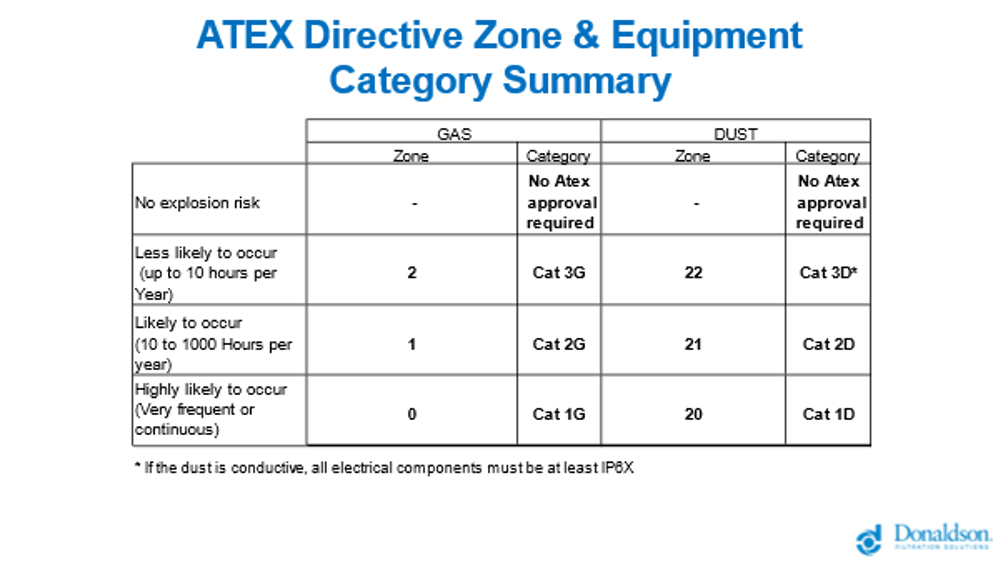The dangers posed by combustible dust are so potentially serious that implementing the minimum safety measures of a mitigation plan and risk assessment are either legally required or highly recommended for most production facilities around the world – even those where the likelihood of an explosion is incredibly small.
This makes being familiar with the specific standards and codes in your region – or regions, given the inevitable geographical variations – vital. In the EU, two main directives are legally required, with ATEX 153 outlining minimum requirements for the health and safety of employees, and ATEX 114 ensuring that equipment suppliers such as Donaldson provide the most-effective solutions to make potentially explosive atmospheres safer.

Previously known as ATEX 137 or the ‘social’ or ‘workplace’ directive, ATEX 153 1999/92/EC requirements oblige employers to evaluate the potential risk at their premises, whether or not explosive dust is likely. Assuming they have sufficient knowledge, this risk assessment can be performed – on a regular basis – by the employer’s own Health & Safety personnel, using the checklist in Article 8 of the Directive to help address current combustible dust risks.
Integrating risk-mitigation planning may well reduce financial outlay while keeping the explosion risk-assessment process on track. And, while the most advanced mitigation technologies may have higher initial price tags, when compared with the overall cost of a combustion event, including the potential loss of life resulting from secondary explosions, premium options that reduce downtime, clean-up and damage will invariably seem much-less expensive in the long-term.
From a legislative viewpoint, the most important aspect is to maintain all explosion-prevention documentation, highlighting the steps and mitigations that were (or were not) taken, should an incident occur.
An assessment involves classifying the factory into zones, differentiating between gas or dust explosion risks and their potential likelihood. Harmonized standards from the EN60079 series outline this classification, ranging from No Risk where there is no potential gas or dust atmosphere in the factory, through Zone 22 (or Zone 2 for gas) where the risk may be present for up to 10 hours per year, Zone 21 (Zone 1 for gas) where there is danger for up to 1000 hours per year, and finally Zone 20 (Zone 0 for gas) where there is frequent or continuous risk (see Table 1).
Bear in mind that any major changes or new processes – perhaps as a result of increased production rates or advancements in technology – will require a new explosion protection document, so identifying any future plans for remodeling or expansion will be extremely worthwhile. Should process changes lead to the need for a different ATEX certification, equipment can be modified but will need recertification from a notified body or expert to ensure CE conformity.
Constructor’s challenge
A prime example of Zone 20 would be the constant dust cloud inside a dust collector (see Figure 1). This highlights the importance of ensuring that any such equipment – including protective systems such as isolation devices, safety devices such as overload protection devices, or components such as vent ducts – is fully compliant with ATEX 114 Directive 2014/34/EU (formerly ATEX 95).
Figure 1: Example of zoning dust collector

|
NB: Ex Triangle refers to interior explosive atmospheres, e.g. inside a dust collector, while Ex Hexagon is for equipment to be placed within explosive atmospheres. |
By compelling constructors to carry out an Ignition Hazard Analysis, evaluating the risk level of hot surfaces, flames and hot gasses, mechanically generated sparks and static electricity, etc, end-users can rest assured that the equipment they install is not a potential ignition source.
In legislative terms, there is again a distinction made in terms of dust zoning and gas zoning, as well as underground (Group I) and above-ground (Group II) equipment. As a leading manufacturer of Group II equipment, Donaldson can self-declare equipment providing the lowest (Normal) level of protection for gas and dust (3G or 3D), as well as for non-electrical aspects of the High (2G or 2D) level equipment. A notified body is responsible for approval of its electrical systems, however, and for all aspects of the top level of protection. This Very High (1G or 1D) category ensures that no ignition source is present during normal operation, as well as in the event of malfunctions.
And it is at this point where the two ATEX directives intertwine, with the specific level of protection required for operation in a previously specified zone now becoming apparent. So, for example, Zone 22, the lowest dust danger zone, will require 3D-level equipment, while 1D protection will be needed in Zone 20 (see Table 1).
Table 1

Manufacturers, of course, are also obliged to supply equipment with the correct markings and provide clear information on any residual risks, safe use and any limits. Conforming equipment will clearly display ATEX identification in the form of the Ex hexagon, followed by numbers stating the equipment group (e.g. II for above ground) and the safety category (e.g. 1 for Zone 20/0), plus the letter D or G to signify the type of explosive atmosphere. The next two sets of markings verify the dust group (combustible, conductive or non-conductive) and temperature class.
When it comes to hazardous and combustible dust, Donaldson can help develop a risk-mitigation solution that meets unique needs. From the initial site visit and process audit to installation and compliance support, Donaldson can help ensure the right solution is in place, keeping dust management front and centre. Find out more about combustible dust and appropriate mitigation solutions on the Donaldson website.
Read more on this topic in the July 2023 issue of Filtration+Separation magazine.





